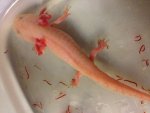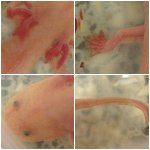Sarahanne
New member
- Joined
- Feb 3, 2013
- Messages
- 5
- Reaction score
- 0
- Points
- 0
- Country
- United Kingdom
Hi,
About a week ago my mum threw me out of the house and put my axolotl and the rest of my things in the shed. I wasnt aware of how long she was in the shed, I was then told she was in there all morning and afternoon! Ever since then she's been stressed on and off.
Lately my axolotl has been very lazy. I feed her in a certain corner of the tank and she will sit in that corner when she is hungry. This morning she was in her hide and I didn't think it was unusual as usually during the morning she's in there. Later on in the afternoon I checked on her and she was floating at the top of her hide on her side. I moved her hide and she floated to the top not moving at all. I really though she was dead. I poked her and she still didnt move at all, her eyes were glazed over, her skin had a cloudy mist around it and her toes were black. I really thought she was dead until I saw her gills move.
I put her in the fridge to see if she got any better, she's now moving and breathing better and her skin looks better but her tail is so vainy and bent weird.
I've been really worried that she's blind lately. I know they smell for their food but whilst she was in the container I put her food in one corner and she went to a totally
Different corner and started trying to eat but there was nothing there and she did that with every corner. Also the last time I fed her when she was in her tank she couldn't find her food for ages she was just looking round and biting so I had to guide her.
Her tank is 45 litres. I've already checked the water and that is totally fine. All I can think of is if the water ended up to warm for her as my mum didnt give me my heater or thermometer. I'm also thinking it may also be the food. I feed her frozen blood work but this batch of blood worm has little grey things in the cubes. I found a leaf in one of them!
Please help me because I really don't know what to do :-( I've been recommended to put an Indian almond leaf in the filter, I have about 10 of them last time it cured her. Should I do this again????
About a week ago my mum threw me out of the house and put my axolotl and the rest of my things in the shed. I wasnt aware of how long she was in the shed, I was then told she was in there all morning and afternoon! Ever since then she's been stressed on and off.
Lately my axolotl has been very lazy. I feed her in a certain corner of the tank and she will sit in that corner when she is hungry. This morning she was in her hide and I didn't think it was unusual as usually during the morning she's in there. Later on in the afternoon I checked on her and she was floating at the top of her hide on her side. I moved her hide and she floated to the top not moving at all. I really though she was dead. I poked her and she still didnt move at all, her eyes were glazed over, her skin had a cloudy mist around it and her toes were black. I really thought she was dead until I saw her gills move.
I put her in the fridge to see if she got any better, she's now moving and breathing better and her skin looks better but her tail is so vainy and bent weird.
I've been really worried that she's blind lately. I know they smell for their food but whilst she was in the container I put her food in one corner and she went to a totally
Different corner and started trying to eat but there was nothing there and she did that with every corner. Also the last time I fed her when she was in her tank she couldn't find her food for ages she was just looking round and biting so I had to guide her.
Her tank is 45 litres. I've already checked the water and that is totally fine. All I can think of is if the water ended up to warm for her as my mum didnt give me my heater or thermometer. I'm also thinking it may also be the food. I feed her frozen blood work but this batch of blood worm has little grey things in the cubes. I found a leaf in one of them!
Please help me because I really don't know what to do :-( I've been recommended to put an Indian almond leaf in the filter, I have about 10 of them last time it cured her. Should I do this again????
Attachments
Last edited:



